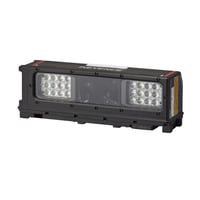
Scan Tunnel System
ST series
Scan tunnel code reader ST-R1000

*Please note that accessories depicted in the image are for illustrative purposes only and may not be included with the product.
Specifications
Model | ST-R1000 | |||
Type | Scan tunnel code reader | |||
Light emitter | Light source | 24 white LEDs | ||
LED Risk Groups | Risk Group 1 | |||
Status LED | 7-color LED | |||
Aimer | - | |||
Reading specifications | Supported symbols | Barcode | CODE39, ITF, 2of5 (Industrial 2of5), | |
2D code | QR, MicroQR, DataMatrix (ECC200), DMRE, GS1 DataMatrix, PDF417, MicroPDF417, | |||
I/O Specifications | Control communication (ST-Series Link) | Network configuration | Ethernet daisy chain | |
Maximum communication distance between units | 10 m 32.8' | |||
Connector type | M12, 4-pin, female, D-code | |||
Number of ports | 2 | |||
Supported protocols | ST-Series Link | |||
I/O Specification | Ethernet (Image and log communication) | Communications standard | IEEE 802.3 compliant 1000BASE-TX | |
Connector type | M12, 8-pin, female, X-code | |||
Number of ports | 1 | |||
Supported protocols | TCP, FTP, SFTP, DHCP | |||
Current consumption | Power voltage | 24 VDC ± 10% | ||
Rated current consumption/Power (A/W) | 2.6 A / 62.4 W | |||
Standby current consumption/Power (A/W) | 1.8 A / 43.2 W | |||
Environmental resistance | Enclosure rating | IP67 | ||
Ambient temperature | 0 to +45°C 32 to +113°F | |||
Relative humidity | Max. 85% RH (no condensation) | |||
Storage temperature | –10 to +50°C 14 to +122°F | |||
Storage relative humidity | Max. 85% RH (no condensation) | |||
External dimensions L × W × H (mm inch) | 102×342×117 | |||
Certifications | CSA, FCC, ICES, BSMI, KC, CE, UKCA | |||
Weight | 2.7 kg 5.95 lb | |||
*1 LED/lamp products are classified as follows according to IEC 62471 (JIS C 7550). | ||||




